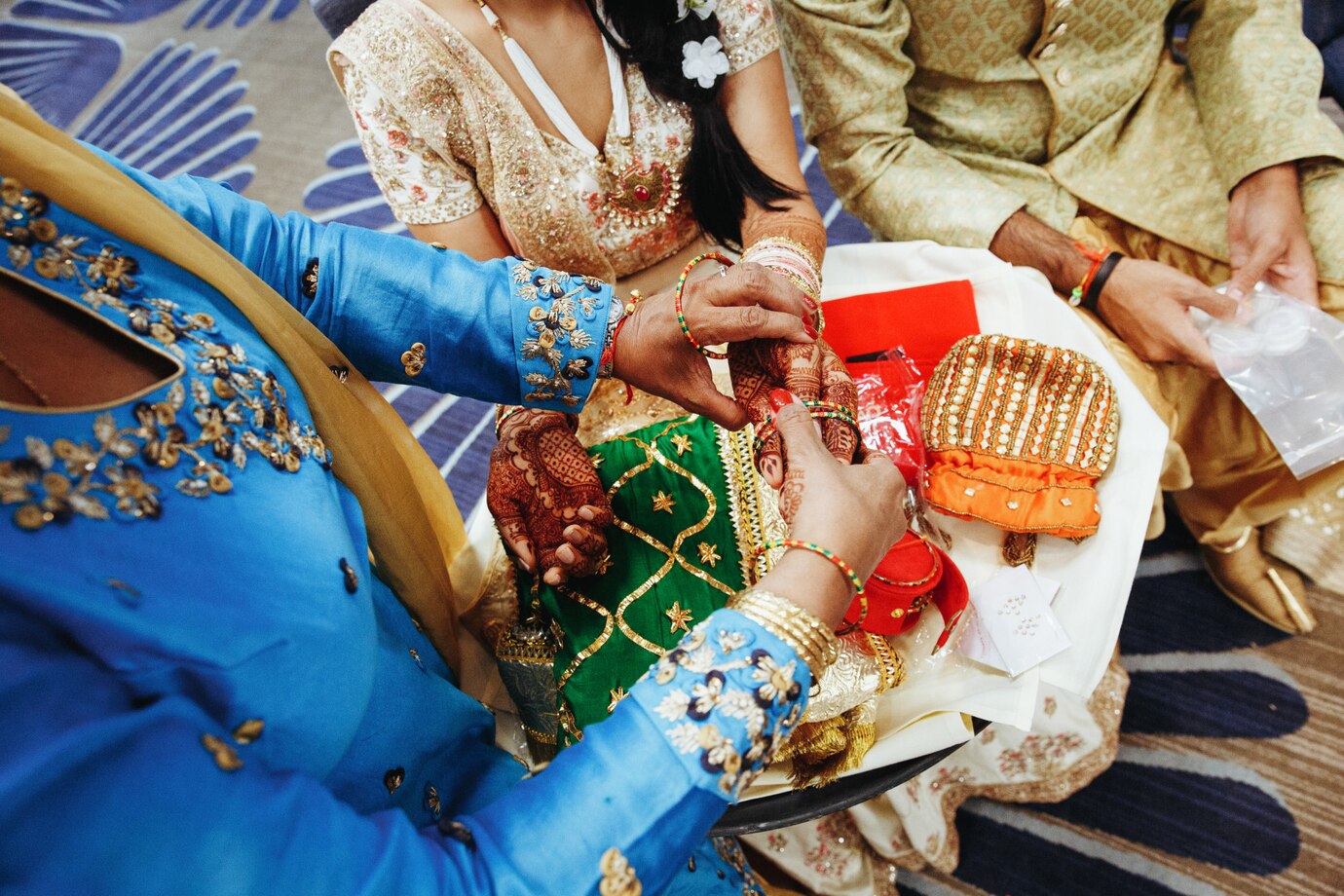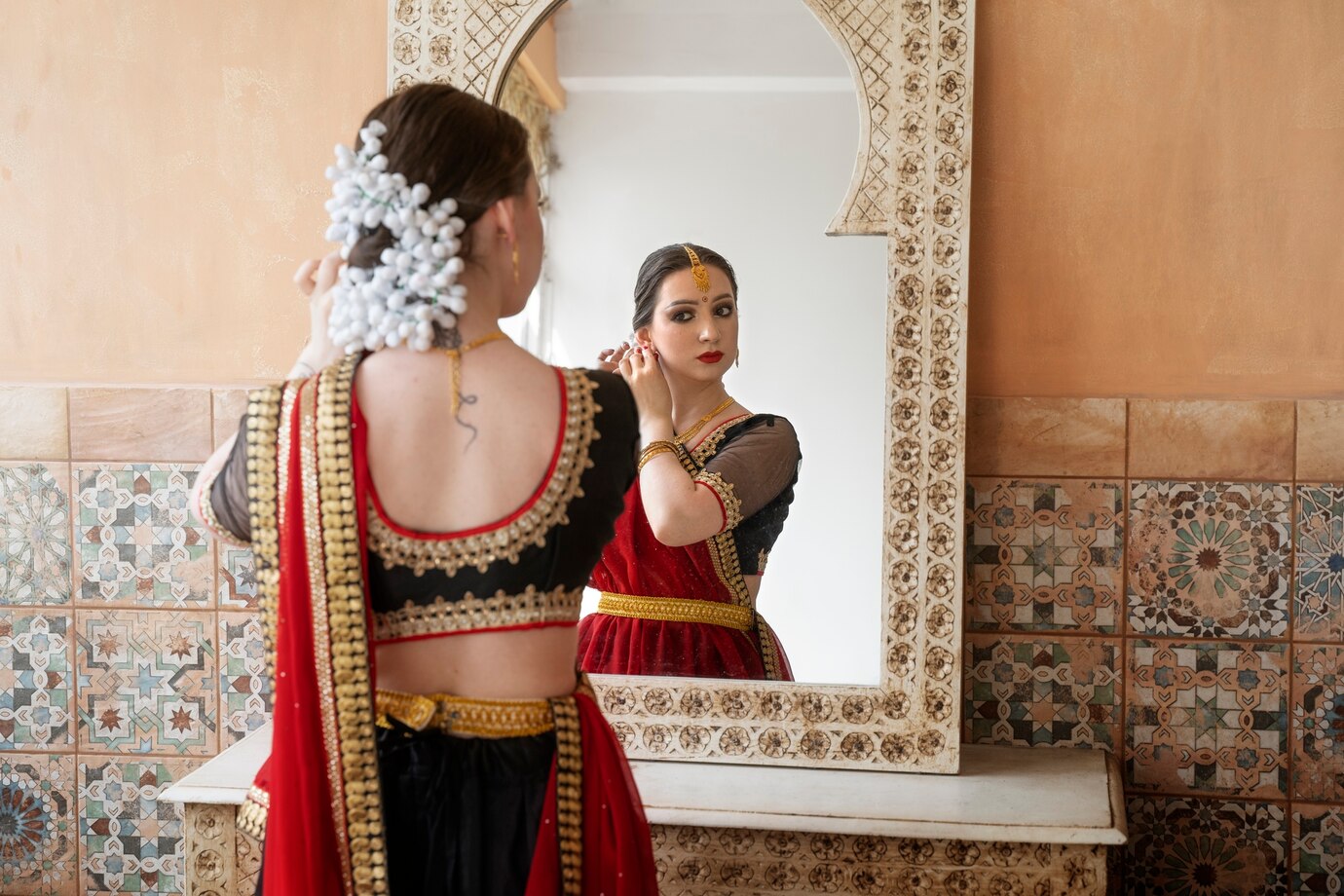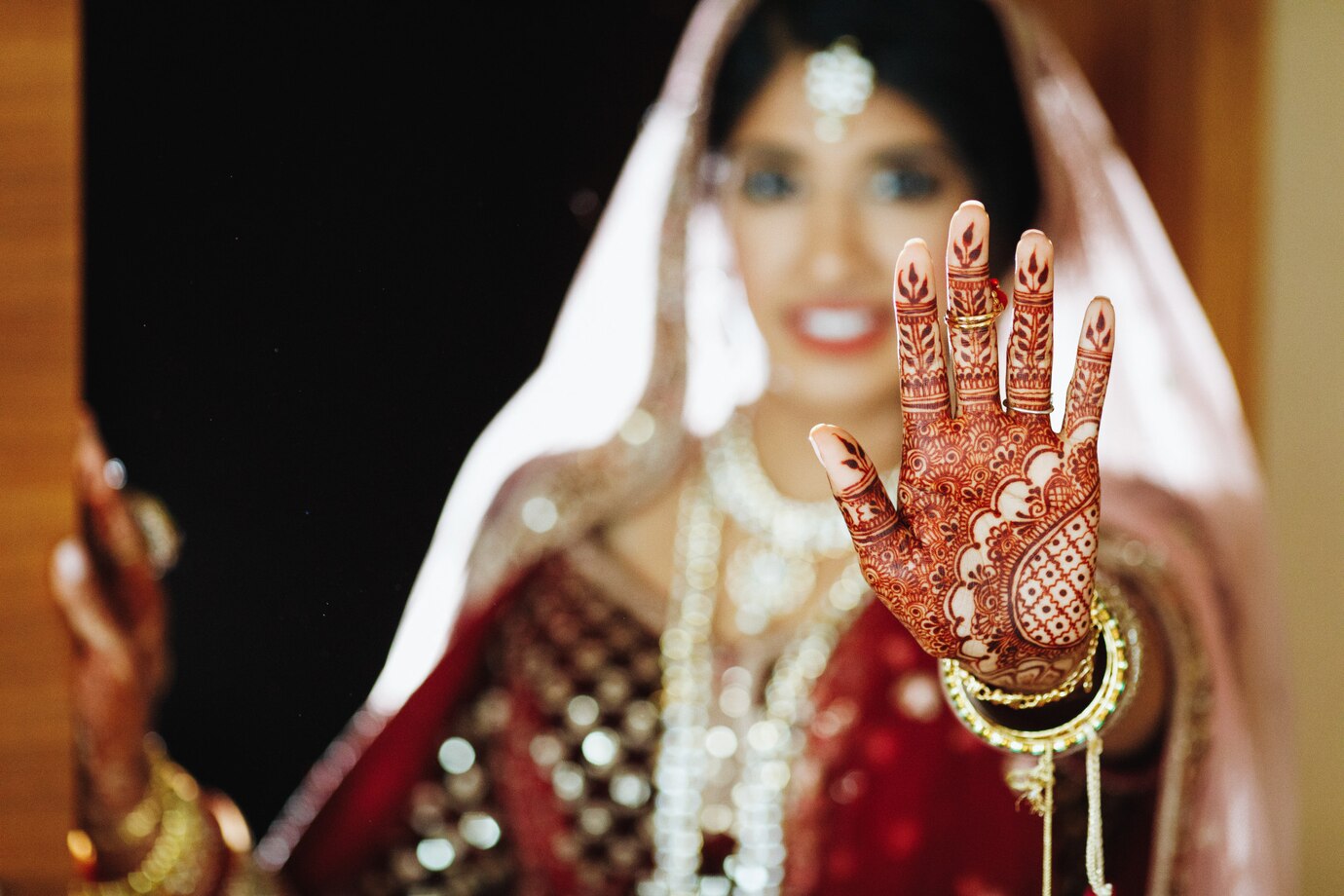In the vibrant tapestry of global matrimonial traditions, the Hindu wedding stands out with its deeply symbolic rituals, colorful attire, and lively celebrations. Central to this is the figure of the Hindu bride, a blend of strength, grace, and tradition. In India, brides are often seen as the embodiment of Lakshmi, the goddess of wealth and prosperity, bringing blessings and fortune to their new families.
The traditional attire of a Hindu bride is the sari or lehenga, intricately designed and typically red, symbolizing prosperity and fertility. Embellished with fine embroidery and complemented by gold jewelry, she presents an image of breathtaking elegance. The ceremony itself includes several rituals, each steeped in ancient tradition, such as the Kanyadaan and Mangalsutra, which signify the offering of the daughter by her father and the symbol of marital commitment, respectively.
Beyond the physical preparations, a Hindu bride undergoes numerous religious and spiritual preparations to prepare for her lifelong commitment. This includes ceremonies like the Haldi, where a paste made of turmeric, sandalwood, and other herbs is applied to her skin by family and friends to bless her before the big day. Each ritual, decor, and hymnal sung is rich with meaning, meticulously carried out to ensure a prosperous and happy marriage.
The Journey of Indian Brides in the USA
Indian brides in the USA bring a colorful spectrum of traditions and customs to their weddings, blending the rich cultural heritage of their homeland with Western influences. This fusion creates a unique celebration, which respects and showcases their native traditions while adapting to a new cultural environment.
For many Indian brides for marriage in the USA, finding the right balance between tradition and modernity can be a delightful challenge. Ceremonies are often a blend of religious elements respected in both cultures. For example, Indian brides might walk around the fire (Agni), a sacred element in Hindu weddings, symbolizing the purity of their union, followed by an exchange of rings, a common Western tradition.
The attire of Indian brides in the USA also reflects this blend, with many opting for traditional Gold laden saris for the ceremony and then changing to a more contemporary dress for the reception. With immigration broadening the horizon of matrimonial styling, darker-skinned Indian brides have found new ways to shine, proudly wearing their beautiful traditional attires with a modern twist that suits their personal style and the aesthetic of the American wedding.
As the concept of the Indian mail-order bride fades, replaced by the empowered, independent Indian woman seeking a life-partner via dating sites and matrimonial platforms, the approach towards marriage and how these weddings are planned and celebrated continues to evolve. Platforms dedicated to helping people find Indian brides have become more focused on relationship compatibility rather than merely facilitating a matrimonial alliance.
Unveiling South Indian Bride Traditions
South Indian brides are a vivid symbol of India’s diversity, each state offering a different flavor of tradition. From Karnataka to Kerala, Telangana to Tamil Nadu, the customs and costumes of South Indian brides display a fascinating array of cultural heritage.
The traditional attire of South Indian brides is the Kanjeevaram saree, renowned for its vibrant colors and rich silk with detailed gold-threaded borders. Unlike many North Indian brides who typically wear red, South Indian brides don more diverse colors like gold, blue, and green. This not only sets them apart visually but also underscores the variety of traditions present in Indian culture.
The rituals too differ significantly. For instance, the Tamil Brahmin community has a unique tradition called the Kashi Yatra. During this playful ritual, the groom pretends to leave for the city of Kashi, renouncing all worldly attachments. The bride’s father then has to persuade him to return and marry his daughter. Such distinct traditions add layers of meaning and entertainment to South Indian weddings.
The jewelry worn by South Indian brides is unique in its composition. Known particularly for the ‘Temple Jewelry’ made of gold and embedded with precious gemstones, it is designed to add spiritual and physical luminance to the bride, making her appear no less than a goddess on her special day.
South Indian weddings, whether held in the lush landscapes of India or across the seas in the USA, continue to enchant with their splendid display of customs, each ceremony a beautiful note in the symphony of marital celebrations. Ceremonies remain deeply rooted in traditions that reverence the sanctity and importance of marriage, making the South Indian bride’s experience uniquely reverential and enriched with ancestral blessings.

The Unique Practices of North Indian Brides
In the tapestry of global weddings, North Indian brides stand out with their vivid colors and distinct rituals. Influenced deeply by cultural heritage, these brides combine tradition and personal style in their wedding attire and ceremonies. A North Indian bride is easily recognized by her stunning outfit of a heavily embroidered lehenga or saree, adorned with intricate jewelry and her pivotal accessory, the dupatta draped gracefully over her head.
Indian brides often choose red or maroon as their primary color due to its association with prosperity and fertility. The elaborate rituals that define North Indian weddings start with the ‘Roka’ and go all the way to the ‘Vidaai’, each step replete with symbolic meanings and ancestral prayers. The ‘Haldi’ ceremony, where a paste of turmeric is applied to the bride (and groom’s) skin for purification and beautification, is a key pre-wedding event that shows the community’s role in preparing her for matrimony.
For many North Indian brides, these practices are not just ceremonial but a celebration of their heritage, transforming the bride into a queen of the old-world, even if only for a moment. While modern influences are creeping into traditions, the essential elements like the ‘Saat Phere’ walking around the sacred fire seven times remain untouched, symbolizing the inseparable bond the couple vows towards.
Hindu Brides and Modern Matrimony
The transition from age-old rituals to embracing modern matrimony practices among Hindu brides is as graceful as it is dramatic. While they still hold fast to the various rites that Indian weddings are famous for, many Hindu brides are now blending contemporary style with traditional formalities.
If in the past being a bride meant embracing hand-me-down jewelry and saris, today’s Hindu bride opts for bespoke pieces and designer wear suited to her personality. Yet, customs like the ‘Mangal Sutra’, a necklace tied by the groom around the bride’s neck, and ‘Sindoor,’ red vermilion applied in her hair parting, stay intact as they signify a woman’s marital status in Hindu society.
As social paradigms shift, so do the preferences of Hindu brides. Dark-skinned Indian brides are now celebrated more , showcasing the shifting perceptions towards beauty standards in Indian culture. Modern Hindu brides in India and in the USA are reshaping the narratives by choosing to mix comfort with style, allowing them to dance a little longer, and a little freer, at their Sangeet ceremony.
Technological improvements have also made a significant impact. Platforms that help find an Indian bride for marriage or visit sites to seek a Hindu bride have become increasingly popular. Proximity no longer restricts love, as evidenced by the thriving presence of Indian brides in the USA who maintain their cultural identity while embracing new traditions.
The Phenomenon of Bride Buying in India
Bride buying, an issue fraught with ethical and legal questions, remains a hidden facet of matrimonial practices in some parts of India. Despite its prohibition, the transactional nature of arranged marriages can sometimes segue into the murky territory of human trafficking.
In certain remote areas, socio-economic pressures compel families to engage in the bride buying practice, which often disregards the consent of the woman. This practice not only infringes on human rights but also perpetuates the cycle of poverty and illiteracy in communities involved in bride buying in India.
Organizations and activists across the country are striving to educate and empower communities to shift away from such malpractices. The focus is on uplifting the socio-economical standards and promoting gender equality in these regions. Legislation and enforcement have been strengthened over the years to prevent bride buying, with stringent penalties that act as a deterrent.
The media too plays a pivotal role in shedding light on this grim issue and supporting change by creating awareness and fostering a public discourse. It’s crucial for further research and dialogue to address the root causes that enable such practices to persist. Only by understanding can effective solutions be crafted to protect countless young women across India who are currently at risk of being bought as brides.

This complex issue highlights a stark contrast between the romanticized image of Indian weddings and the harsh realities faced by some women. Moving forward, it is imperative to address these challenges directly, ensuring a safer and more dignified approach to marriage in all sects of Indian society.
Bridal Beauty Redefined
In the vibrant mosaic of Indian culture, weddings are iconic celebrations of love and unity, and the bride often becomes the symbolic cornerstone of these festivities. Traditionally, the beauty standards imposed on Indian brides have tilted significantly towards lighter skin tones. This preference roots deeply in historical, social, and media influences that equate fair skin with attractiveness and desirability. However, the contemporary landscape is witnessing a remarkable shift, celebrating the charm and allure of dark-skinned Indian brides.
Dark-skinned Indian brides are now embracing their natural beauty, adorned in stunning bridal attire that complements their rich skin tones. The conventional lehenga (a long, embroidered, and pleated skirt worn with a matching blouse and scarf) and saree hues have been set aside for bolder and darker colors that accentuate their inherent beauty. Ruby reds, deep maroons, royal blues, and emerald greens are increasingly becoming the colors of choice for these brides.
Makeup artists are also playing a crucial role in this transformation by highlighting rather than concealing the natural skin color of Indian brides. Techniques such as contouring and highlighting enhance their features, showcasing their true beauty without altering their skin tone. This shift not only impacts the brides but also influences the audience, setting a stage where beauty is celebrated in all its forms and colors.
Indian Mail Order Brides and Transnational Ties
The concept of Indian mail order brides isn’t new, but it’s been evolving constantly with the internet broadening the scope of how and where relationships can materialize. Today, Indian mail order brides not only signify the bridging of geographical boundaries but also the crossing of cultural and traditional limits.
Many Indian women and men are now looking to the world of online matchmaking to find suitable partners from across the globe. This setup not only provides a wider array of possibilities but also opens up a dialog between different cultural narratives. Indian mail order bride services are thus not only platforms for meeting future partners but also spaces for cultural exchange and mutual understanding.
Men from various parts of the world, including the USA, are increasingly interested in brides from India due to their commitment to family values, deep-rooted cultural practices, and the balance they maintain between modern ideals and traditions. These cross-national marriages are supported by websites that cater specifically to those looking for Indian brides for marriage, where they can connect, communicate, and understand the potential bride’s background, interests, and life goals.
How to Find an Indian Bride?
Finding an Indian bride involves more than just loving Indian culture or appreciating its festive vibrancy. It’s about respecting the traditions, understanding the values, and being prepared to integrate into a culturally rich lifestyle. Here are some tips for finding the ideal Indian bride:
- Explore Reputable Dating Platforms: Always opt for trustworthy and well-reviewed platforms whether you are looking at options for Indian mail order brides or more traditional forms of matchmaking. These platforms offer a variety of filters to narrow down options according to your preferences in terms of cultural and individual criteria.
- Understand the Importance of Culture: Indian culture is diverse, it varies significantly from North to South and East to West. North Indian brides might have different customs and food preferences compared to South Indian brides. Appreciating these nuances is crucial to building a respectful and loving relationship.
- Communicate Openly: Once you connect with potential Indian brides in the USA or elsewhere, ensure open and honest communication to understand their life ambitions, values, and worldviews. This foundational bond is significant for a lasting relationship.
- Be Mindful of the Commitment: Entering into a marriage with an Indian woman involves deep commitment. Indian weddings are rich in rituals and are profound commitments not just between the two individuals but also between their families.
Matching with the right Indian bride calls for patience, understanding, and an appreciation for the rich tapestry of Indian culture. By valuing her background and fostering genuine connections, forming a lasting relationship is not just a possibility but a delightful future reality.





